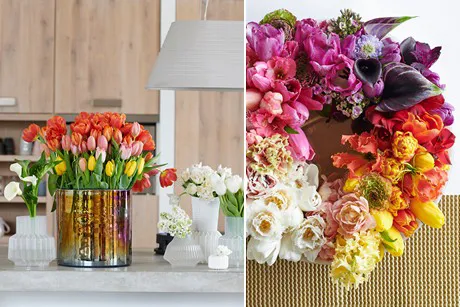Fresh green foliage, unique shapes and fabulous colours: the tulip (Tulipa) is the ideal way to kickstart the year and bring a bit of spring into the home. Because the bulbs require more time to bloom outdoors, tulips that are grown as cut flowers get special treatment. The grower gives the bulbs an artificial winter period, after which the higher temperatures in the greenhouse make them think that it’s spring and so start flowering. The bulbs are therefore really tricked and ‘forced’ to flower in the greenhouse so that florists and consumers can enjoy these spring flowers early.

Origin
The tulip is native to Iran, Afghanistan and Kazakhstan. Nomads brought the bulbs to Turkey, where they became incredibly popular. Ottoman sultans wore a tulip as a symbol on their turban: 'tulip' comes from the Persian word ‘tulipan’ which means ‘turban’. Nowadays tulips are particularly associated with the Netherlands, the largest supplier of tulips as both bulbs and cut flowers.
Assortment
With over 600 cultivars the choice of tulips is extensive. The flowers are often even-coloured, but are also available with flames, coloured stripes and coloured edges. Tulips are classified by flower shape: single and double flowered, parrot tulips, lily-flowered tulips or in the form of fringed or Crispa tulips. The double tulips that resemble peonies are particularly unusual.
Care tips for professionals
- Store tulips for as little time as possible.
- Storing tulips cool prevents them from ripening further. A storage temperature of 2 - 5°C is best.
- On arrival in the shop wrap the tulips tightly in paper and leave them to straighten up in a shallow layer of water. This prevents them from growing crooked. Cut off the white part at the bottom of the stem in order to make it easier to take up water.
- Work clean and dry, avoid condensation or getting the flower and leaves wet because of the risk of botrytis, which greatly detracts from the decorative value.
- Cut tulips can continue to grow by 5 to 15 cm: something to take into account when incorporating tulips in bouquets and arrangements.
- Tulips can only be combined with the daffodils if you use Bulb Flower Chrysal.
Display tips for professionals
Create colour blocks on the shelf or on the shop floor with bundles of tulips and give unusual cultivars a separate place in order to emphasise that these are specialities. The 2019 trend is for very traditional or very contemporary arrangements. For traditional arrangements think of the atmosphere of an old still-life: deep, saturated colours in a jug or earthenware pot or a tulip vase. The modern style is full of twists: tulips where only the flowers are visible above the edge of the opaque vase, or which are placed so deep in a transparent vase that it almost looks like a terrarium. Their smooth stems make tulips ideal entry level flowers for millennials and centennials who are ill at ease with leaves and forms. Remove some of the green foliage and present the tulips individually in small bottles and glasses for an Instagrammable display for this new, interesting target group.
For more information:
Funnyhowflowersdothat.co.uk
